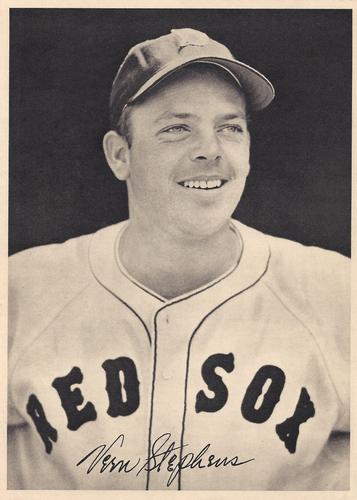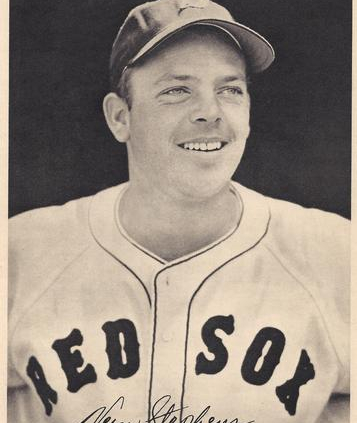May 16, 1950: Ted Williams, Vern Stephens combine for 4 homers and all the runs
 It was a Tuesday afternoon at Ted Williams’s favorite homer haven – Briggs Stadium in Detroit. His first nine home runs of 1950 had all come at home, at Boston’s Fenway Park.
It was a Tuesday afternoon at Ted Williams’s favorite homer haven – Briggs Stadium in Detroit. His first nine home runs of 1950 had all come at home, at Boston’s Fenway Park.
This game became something of a “Ted and Junior” show. Williams hit two home runs in the game and so did Vern “Junior” Stephens. Both of Stephens’ homers were solo home runs. Both of Williams’s were two-run homers.
Between them, they accounted for all of the Red Sox runs in a 6-1 win over the Detroit Tigers, a win that propelled the Red Sox into first place in the American League standings by a half-game over the New York Yankees.
The season was a month old and the Red Sox and Yankees were atop the American League standings, essentially tied for first place, with the Yankees a half-game behind. Detroit had the edge in percentage points, their 13-6-1 record providing a winning percentage of .684, while the Red Sox, who had played seven more games, were 17-10 (.630). Indeed, by percentage points, the 14-8 Yankees (.636) were also ahead of the Red Sox.
The game was the first of a 15-game Red Sox road trip that lasted to the end of the month. Tigers fans turned out – the game drew 20,369.
Starting for Red Rolfe’s Tigers was Art Houtteman, a 22-year-old right-hander already in his sixth season in the majors, who had enjoyed a good 15-10 (3.71) season in 1949. Two months later, he was selected for the 1950 All-Star team. He faced four Boston batters in the first inning, walking one of them – Ted Williams. Joe Dobson, pitching for the Joe McCarthy-led Red Sox, set down Detroit in order in the bottom of the first.
Both teams had a player hit a single in the second, but the first runs weren’t scored until the third. Center fielder Dom DiMaggio led off for the Red Sox and reached on an error by Tigers shortstop Johnny Lipon. Right fielder Al Zarilla singled to center field; DiMaggio tried to go first to third but was thrown out at third by Johnny Groth.
Ted Williams came up and homered into the upper deck in right field to give Boston a 2-0 lead. Vern Stephens followed up Williams’s home run with one of his own, this one to left field. No further scoring occurred in the inning.
In the Tigers’ third, Dobson began to get himself in trouble, walking the first two batters, catcher Aaron Robinson and Houtteman. But Lipon flied out to right and second baseman Jerry Priddy hit into a 5-4-3 double play.
A couple of Red Sox singled in the fourth but Williams made the third out by lifting a fly ball to the first baseman, Dick Kryhoski. The Tigers got two on base, too, with a two-out walk and a single, but Dobson struck out Kryhoski.
Neither side got a man on base in the fifth or sixth save for Boston’s first baseman Walt Dropo reaching on another error by shortstop Lipon.
In the top of the seventh, Zarilla flied to right and Williams flied to right, but Junior Stephens hit his second home run of the game, another solo home run, again to left field. The score stood 4-0 at the midway point of the seventh inning.
After the seventh-inning stretch, Groth drew a one-out walk off Dobson. With two outs, Aaron Robinson singled to center field, sending Groth to second, and second baseman Bobby Doerr’s error allowed Groth to score. The Boston Herald’s Arthur Sampson said the ball really took “a freak hop and bounced away toward right field.”1 Charlie Keller pinch-hit for Houtteman and flied out to Johnny Pesky at third base.
Reliever Hal White set down the Red Sox in order in the top of the eighth, and Dobson dug another hole for himself in the bottom of the inning. To start with, Lipon singled to center field. On a wild pitch to Priddy, Lipon took second base. He scooted to third when Priddy hit one back to Dobson, who went for the sure out at first base.
Third baseman George Kell, the 1949 batting champion (his batting average was .3429118 to Ted Williams’s .3427561) reached first on a single to Stephens at shortstop, but Priddy had to hold at third base. Right fielder Vic Wertz flied out to Williams in left field. It wasn’t deep enough for Priddy to tag; Williams was known to have a decent arm. Left fielder Hoot Evers drew a walk, loading the bases and becoming the tying run on first base. Groth had two singles and a walk at this point in the game. But this time Dobson got Groth to hit the ball right back to him, and he threw him out at first base.
With two outs in the top of the ninth, Zarilla walked. Williams hit another home run, extending the Red Sox’ lead to 6-1. Like the first, it was hit into a “stiff wind blowing against him.”2 It was a carbon copy of his earlier home run. “Both Williams’ drives ended far up in the upper deck of the right field stands,” noted the Detroit Times.3
The last Boston batter to come to the plate in the ninth was Stephens. Said the Boston Globe, Stephens “made quite a bid for a third homer. Hoot Evers caught his drive a foot from the barrier in left center – 365 feet from the plate.”4 Robinson singled for Detroit in the bottom of the ninth but never got past first base, and the Red Sox closed out the win.
Stephens had hit his two home runs off Houtteman. Williams hit his first one off Houtteman and the second one off White. The Williams home runs were his 10th and 11th of the year. He was hitting them at a faster clip than in any other year, and at a faster pace than Babe Ruth had in 1927 on his way to 60.5 Williams’s four RBIs edged him ahead of Stephens, 32 to 31.
The game was Joe Dobson’s 100th career win, a six-hitter (all singles) with no earned runs, marred a bit by five bases on balls and just two strikeouts. He went to 4-2 in the still-young season. The loss dropped Houtteman to a matching 4-2 record.
As many baseball fans realize, the way things look in the standings can be illusory. The Red Sox’ win over the Tigers showed them in first place in the league standings – but it was the last day all season long that the standings had them on top. In fact, the Yankees won this day as well; even with the Tigers losing and showing as a full game behind Boston in the standings, the Red Sox still ranked third in percentage points.
When all was done in 1950, the Yankees had won the pennant for the second season in a row. The Tigers finished second, three games behind New York, and the Red Sox finished one game behind the Tigers.
Acknowledgments
This article was fact-checked by Kevin Larkin and copy-edited by Len Levin.
Sources
In addition to the sources cited in the Notes, the author consulted Baseball-Reference.com and Retrosheet.org.
https://www.baseball-reference.com/boxes/DET/DET195005160.shtml
https://www.retrosheet.org/boxesetc/1950/B05160DET1950.htm
Notes
1 Arthur Sampson, “Four Sox Homers Blast Tigers, 6-1,” Boston Herald, May 17, 1950: 16.
2 Sampson.
3 Leo Macdonell, “Belting of Williams, Stephens Tumbles Tigers from Top Rung,” Detroit Times, May 17, 1950: 29.
4 Hy Hurwitz, “Williams and Stephens Homer Twice as Sox, Dobson Defeat Tigers, 6-1,” Boston Globe, May 17, 1950: 20.
5 Edgar Hayes, Williams in Assault on Bambino’s Record,” Detroit Times, May 17, 1950: 29. This was the year in which Williams broke his elbow in the All-Star Game, squelching what was truly shaping up to be a historic season.
Additional Stats
Boston Red Sox 6
Detroit Tigers 1
Briggs Stadium
Detroit, MI
Box Score + PBP:
Corrections? Additions?
If you can help us improve this game story, contact us.


